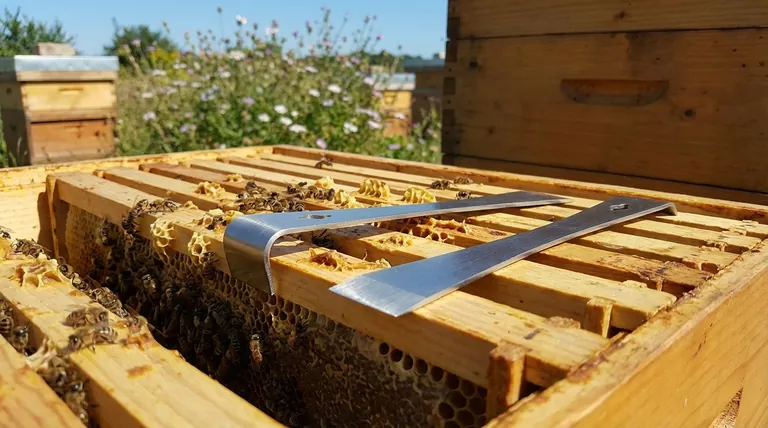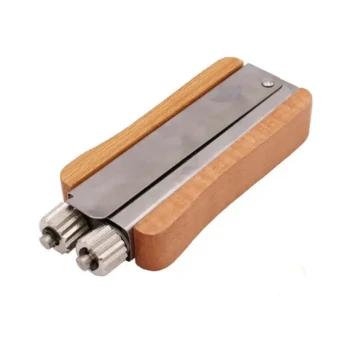At its core, the J-hook hive tool is a specialized lever for lifting frames. Its primary purpose is to give the beekeeper a simple, powerful, and controlled way to lift propolis-sealed frames out of the hive box. By using the adjacent frame as a fulcrum, the J-hook provides significant mechanical advantage, making the process effortless and preventing damage to the wooden frames and delicate comb.
The J-hook isn't just a minor feature; it transforms one of beekeeping's most common frustrations. It turns the sticky, jarring task of prying out frames into a smooth, controlled lift, protecting your equipment and reducing stress on your bees.

The Hive Tool's Fundamental Role
To understand the J-hook's value, you must first understand the challenge it solves. A hive tool, in any form, is a beekeeper's most essential piece of equipment besides their protective gear.
The Propolis Problem
Bees use a resinous substance called propolis, or "bee glue," to seal every crack and seam inside their hive. They use it to secure frames, patch holes, and strengthen the hive structure.
This natural glue is incredibly strong, effectively cementing hive bodies, inner covers, and especially frames together. Without a pry bar, it is impossible to open a hive or remove a frame for inspection.
A Multi-Purpose Instrument
Beyond prying, a hive tool's sharp, flat edges are used for scraping away excess wax and propolis from hive components. This cleaning is critical for ensuring frames and boxes fit together properly after an inspection.
The J-Hook Advantage: Solving the Frame-Lifting Challenge
While a standard hive tool can pry frames apart, the J-hook model perfects the art of lifting them out.
How the J-Hook Works
The "J" end of the tool is designed to be slipped down into the gap between frames. You then hook it under the top bar of the frame you wish to remove.
By resting the tool on the top bar of the adjacent frame and using it as a pivot point, you can lift the targeted frame straight up with a simple lever action.
The Benefit of Leverage
This leverage is the key. It multiplies your force, allowing you to easily break the propolis seal that holds the frame's end bars to the hive body. This is especially helpful for beekeepers who may lack the hand strength to pry frames out directly.
Preventing Damage
Using a standard tool to pry frames often involves jamming it between the end bars, which can crush wood, damage comb, and agitate the bees. The J-hook's targeted lift avoids this collateral damage entirely, preserving the integrity of your equipment.
Anatomy of a J-Hook Hive Tool
While the hook is its defining feature, the rest of the tool is equally functional and designed for the specific demands of hive work.
The Pry End
The opposite end of the tool is a wide, flat, and often sharp blade. This is your primary pry bar for separating large components, like cracking the seal between two hive boxes or between the top box and the inner cover.
The Scraper Edge
The long, flat side of the tool serves as an effective scraper. It's used to quickly clean unwanted burr comb and propolis buildup from the top bars of your frames, ensuring a clean working surface.
The Nail Puller
Many J-hook tools include a small hole or notch. This is designed to function like the claw of a hammer, allowing you to pull out small nails used in assembling or repairing hive components.
Understanding the Trade-offs
While the J-hook is a superior tool for frame lifting, it's worth noting the subtle differences compared to other options.
J-Hook vs. Standard Hive Tool
A standard hive tool is typically a simple, flat bar with a bent end. It is perfectly functional for prying and scraping. However, it completely lacks the specialized frame-lifting capability of the J-hook, forcing you to pry frames apart from the sides, which is less efficient and more disruptive.
Material and Design Variations
J-hook tools come in different widths and strengths. Some are narrower and lighter, offering more agility in tight spaces. Others are broader and thicker, providing maximum strength and leverage for prying apart heavily propolized boxes. Your choice depends on personal preference and the specific conditions of your hives.
Making the Right Choice for Your Apiary
Ultimately, the tool should match your workflow and priorities.
- If you are a new beekeeper: The J-hook is highly recommended, as it dramatically simplifies one of the most frequent and crucial hive management tasks.
- If you manage many hives: The efficiency, reduced physical strain, and decreased equipment damage provided by a J-hook make it an indispensable asset.
- If you struggle with hand strength: The mechanical advantage of the J-hook is not a luxury but a necessity for making hive inspections manageable.
Choosing the right tool empowers you to work with confidence, precision, and respect for the colony.
Summary Table:
| Function | J-Hook Advantage |
|---|---|
| Frame Lifting | Uses adjacent frame as a fulcrum for a controlled, powerful lift. |
| Prying | Flat blade end separates hive bodies and inner covers. |
| Scraping | Cleans excess propolis and wax from top bars and hive components. |
| Damage Prevention | Targeted lift avoids crushing wood or damaging delicate comb. |
Equip your apiary with the right tools for efficient, damage-free hive management.
At HONESTBEE, we supply commercial apiaries and beekeeping equipment distributors with high-quality, durable tools designed for professional use. The right equipment, like a J-hook hive tool, reduces physical strain on your team and protects your investment in hive components.
Contact our wholesale team today to discuss your equipment needs and discover how our products can enhance your operation's productivity and profitability.
Visual Guide

Related Products
- Professional Stainless Steel Pry-Bar Hive Tool
- HONESTBEE Professional Multi-Functional Hive Tool with Ergonomic Wood Handle
- HONESTBEE Advanced Ergonomic Stainless Steel Hive Tool for Beekeeping
- Stainless Steel J Hook Hive Tool for Beekeeping
- HONESTBEE Professional Long Handled Hive Tool with Precision Cutting Blade
People Also Ask
- What are the different types of hive tools available? Choose the Right Tool for Your Apiary
- What is a standard hive tool and what are its features? The Essential Multi-Function Tool for Beekeepers
- What equipment and implements are needed by beekeepers besides the hives? Build Your Essential Beekeeping Toolkit
- What additional safety equipment should beekeepers use? Essential Tools for Hive Management
- What types of hive tools are available for beekeepers? Choose the Right Lever for Your Apiary



















